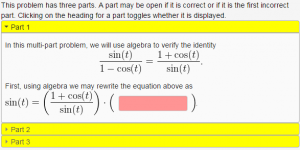ProvingTrigIdentities3
Revision as of 18:42, 13 June 2015 by Paultpearson (talk | contribs)
Proving Trig Identities
This PG code shows how to write a multi-part question in which each new part is revealed only after the previous part is answered correctly. The parts are revealed sequentially on the same html page instead of each part having its own html page. We also cleverly redefine the sine function to require students to simplify their answers when applying well-known trig identities.
- File location in OPL: []
| PG problem file | Explanation |
|---|---|
|
Problem tagging: |
|
DOCUMENT(); loadMacros( "PGstandard.pl", "MathObjects.pl", ); TEXT(beginproblem()); $showPartialCorrectAnswers = 1; |
Initialization: |
Context("Numeric")->variables->are(t=>"Real");
#
# Redefine the sin(x) to be e^(pi x)
#
Context()->functions->remove("sin");
package NewFunc;
# this next line makes the function a
# function from reals to reals
our @ISA = qw(Parser::Function::numeric);
sub sin {
shift; my $x = shift;
return CORE::exp($x*3.1415926535);
}
package main;
# Make it work on formulas as well as numbers
#sub cos {Parser::Function->call('cos',@_)} # if uncommented, this line will generate error messages
# Add the new functions to the Context
Context()->functions->add( sin => {class => 'NewFunc', TeX => '\sin'}, );
#
# You manually define the answers
#
@answers = ();
$answers[1] = Formula("1-cos(t)");
$answers[2] = Formula("sin(t)");
$answers[3] = Formula("1-(cos(t))^2");
#
# Automatic configuration for answer evaluation
#
@ans_eval = ();
@scores = ();
foreach my $i (1..$#answers) {
$ans_eval[$i] = $answers[$i] ->cmp();
$ans_hash[$i] = $ans_eval[$i]->evaluate($inputs_ref->{ANS_NUM_TO_NAME($i)});
$scores[$i] = $ans_hash[$i]->{score};
}
|
Setup: |
Context()->texStrings;
BEGIN_TEXT
${BBOLD}Part 1 of 3:${EBOLD}
$BR
$BR
In this multi-part problem, we will use algebra to verify
the identity
$BCENTER
\( \displaystyle \frac{ \sin(t) }{ 1-\cos(t) } = \frac{ 1+\cos(t) }{ \sin(t) }. \)
$ECENTER
$BR
First, using algebra we may rewrite the equation above as
$BR
$BR
\( \displaystyle \sin(t) = \left( \frac{1+\cos(t)}{\sin(t)} \right) \cdot \Big( \)
\{ ans_rule(20) \}
\( \Big) \)
END_TEXT
Context()->normalStrings;
ANS( $ans_eval[1] );
|
Main Text and Answer Evaluation Part 1: |
if ($scores[1]==1) {
Context()->texStrings;
BEGIN_TEXT
$PAR
$HR
${BBOLD}Part 2 of 3:${EBOLD}
$BR
$BR
Then, using algebra we may rewrite the equation as
$BR
$BR
\( \sin(t) \cdot \big( \)
\{ ans_rule(20) \}
\( \big) = \big(1+\cos(t)\big) \cdot \big(1-\cos(t)\big) \),
END_TEXT
Context()->normalStrings;
ANS( $ans_eval[2] );
} # end if
|
Main Text and Answer Evaluation Part 2: |
if ( ($scores[1]==1) && ($scores[2]==1) ) {
Context()->texStrings;
BEGIN_TEXT
$PAR
$HR
${BBOLD}Part 3 of 3:${EBOLD}
$BR
$BR
Finally, using algebra we may rewrite the equation as
$BR
$BR
\( \sin^2(t) = \)
\{ ans_rule(20) \}
$BR
$BR
which is true since \( \cos^2(t) + \sin^2(t) = 1 \).
Thus, the original identity can be derived
by reversing these steps.
END_TEXT
Context()->normalStrings;
ANS( $ans_eval[3] );
} # end if
COMMENT("MathObject version. This is a multi-part problem
in which the next part is revealed only after the previous
part is correct. Prevents students from entering trivial
identities (entering what they were given)");
ENDDOCUMENT();
|
Main Text and Answer Evaluation Part 3: |
